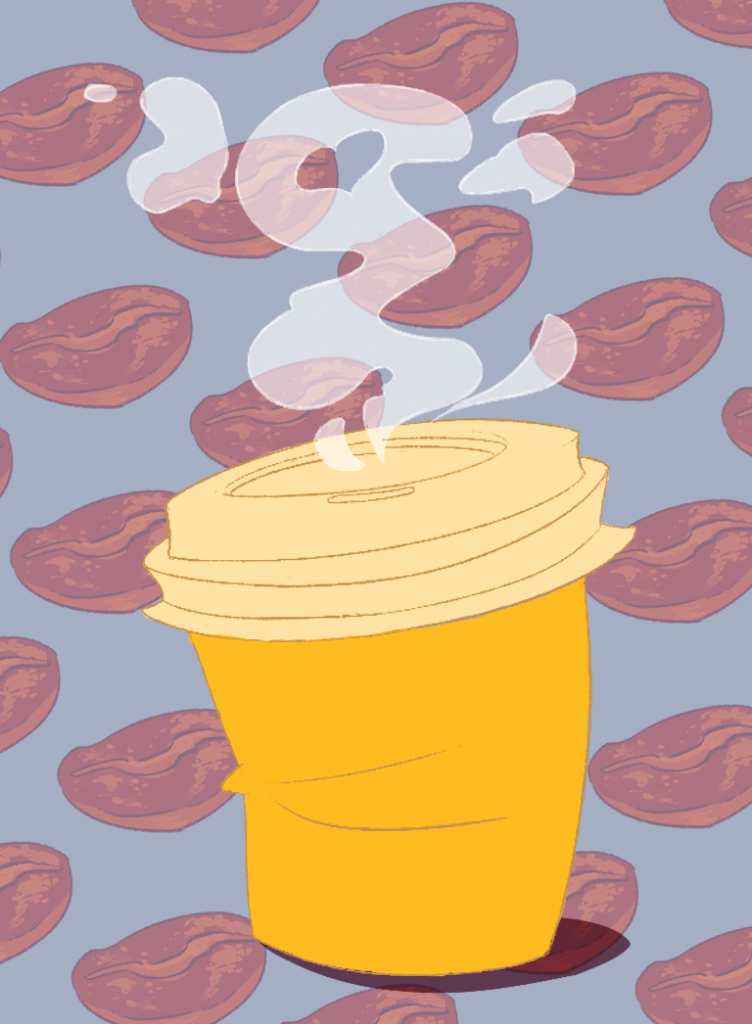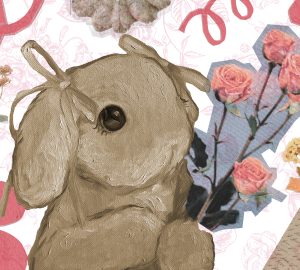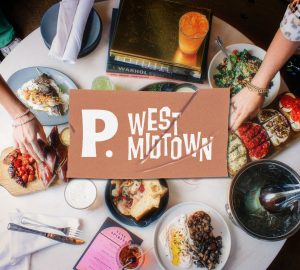by Catalina Cano
It wasn’t an alarm’s high-pitched ringing that woke me up as a child, nor was it the hands of either of my parents rubbing gently at my back. It was the earthy scent crawling through doors and handmade pillowcases until it reached the second floor of my house — the scent of freshly brewed coffee over the stove top clinging to drawn curtains and my father’s work clothes. In Honduran households, it’s not the sunrise that announces the start of the day, but the pouring of that hot drink so hot you see the steam form abstract figures until they dissipate into the air, that triggers most of the population to rise and move. As a child, I was not allowed to partake and instead would wait for my mother to leave her cup unattended so that I could sneak tiny sips without leaving a trace. This acquired taste has been a pleasure to claim.

Coffee is not native to the Honduran territory, yet it has flourished and rapidly paved itself a strong foundation, becoming one of the ten largest coffee producers in the world. It is believed coffee was first introduced in the late 18th century, either by the Spaniards or by foreign traders. From that point on, small coffee farms began to spread throughout the country until the second half of the 20th century when global exportation began for the Honduran coffee industry. Honduras exports more than 9,500 tons of coffee — more than four billion cups of coffee per year — to the United Kingdom alone, which is an enormous amount for a country smaller than the state of Ohio. It has successfully marketed itself as the largest coffee producers in Central America and the third largest in Latin America behind Brazil and Colombia.
Honduras runs and rests on coffee. It has made itself a home within the economy, within society and more importantly, within every individual’s personal life. The coffee culture is not one to be handled with haste. Regardless of how you take your coffee, when consuming it you must make sure you make time for it. It’s not something to be taken on-the-go, nor is it appreciated mainly for its energizing properties. It’s imperative to savor it, and to allow coffee to do its job — bring people closer to one another.
Two years ago, when I moved to Atlanta, I arrived with enough coffee to get by until anyone in my family decided to visit and be kind enough to restock my supply. Though Honduras is in the top ten coffee producers, its market is mostly transcontinental. The odds for me to find Honduran coffee on the shelves of Atlanta supermarkets are extremely slim. During my time in China, finding coffee shops in Beijing that catered Honduran coffee was a regularity, yet I have only witnessed such a thing twice in the United States. I can confess that I like it better this way. The day I witnessed Starbucks serve Honduran coffee from Marcala as part of their Single-Origin Coffees, my heart dropped straight into my stomach to be consumed by gastric juices. I will clarify that a day without me visiting Starbucks is ultimately unfulfilled. The Seattle-founded company is a success, and though I don’t really go there for their coffee, they have managed to keep me hooked and consistent.
My disappointment was not founded by an act of selfishness. The further Honduran coffee beans get, the better. My disappointment was rather founded by the imminent rush behind the coffee culture I have witnessed in the U.S. And if it’s not the rush, it’s the solitude sought by the consumers. Out of all the people in the ridiculously long line I was very much willing to stand in, how many actually stayed to drink their coffee? Very few. Those who did sat with screens and wires as company. I am the same. I find Starbucks as the designated location for productivity, or at least where you can pretend to have any. But above all, I go to Starbucks because I want to be alone. How are people going to bond? I find it ridiculous myself, but seeing that small fragment of home made me uncontrollably lonesome. I got a Frappuccino instead.
My time in the U.S. has shown me that coffee shops here are places to get work done, whereas coffee shops in Honduras, alike many other countries, are places you visit after work. While writing this article, the realization dawned on me that coffee, to me, is a reward, a comfort, my immediate mood booster. Not because of the caffeine, but because growing up, after facing a rough day that would knock me off balance, the only way my family managed to cheer me up was if we all went for a cup of coffee before dinner.
I have been in hospital waiting rooms and funerary homes where those affected cling tightly to a coffee cup for the lack of a hand to hold. You’ll find it in laboratories waiting for you after you get your blood drawn and in after-service church activities. I’ve had specialty coffee drinks in the waiting room of the Toyota Service Center as I waited for my mother’s car to be brought back from its mileage check-up and as I waited in line to make a deposit. Where you must wait or have time to give, chances are you’ll find a cup.
Across Latin America, coffee is the people’s chosen hot beverage — except for Bolivia and Chile that lead in tea consumption. The constant search of high-quality coffee has carved itself into people’s daily habits. In Honduras, the Honduran Coffee Institute or IHCAFE oversees more than 110,000 small coffee farm owners. It is a common sight to encounter a coffee shop in every block. While being constantly on the lookout for new coffee shops to visit within the main cities, many will often be willing to travel large distances into the countryside to savor a variety of tasting notes, which can vary from apricot and tropical fruit, to chocolate and caramel.
It’s common to come across a resident friendly enough to offer you a cup for yourself, and more often than not, it’s from coffee trees grown in their own backyards. The department of Olancho is the largest out of the eighteen Honduran departments, and if I were to define it, I’d call it the Texas of Honduras. It’s a fertile place with unpredictable people which constantly manages to feel like a different country of its own. The people of Olancho possess their own way of speaking and behaving, and its capital city, Juticalpa, is slowly becoming one of the main cities within the nation. Though Olancho homes most livestock farms in the country, every home is perfumed with the scent of coffee. Visit ten houses in Olancho and ten cups of coffee will be served in your direction.
Many things can mold a country: the unstable wildness of mountain ranges that seem to drag until they reach the sea, the teasing nature of natural disasters that are all talk, the gentle embrace of two oceans whose waves seem to always keep their composure. It wasn’t always like that. During late October 1998, Hurricane Mitch — a category-five hurricane larger than the country itself — wiped 80 percent of Honduras’ crops forcing a 50-year setback in the country’s economy after taking more than 7,000 lives and leaving more than 1.5 million people without a safe home to return to.
Hurricane Mitch forms part of the picture of many aspects within the nation, but this monster storm failed to deplete the Honduran lands of its fertility and to consume the people’s willingness to make the coffee industry prosper. After the hurricane became nothing but a dark memory, the Honduran government decided to implement a tax on coffee exports in order to improve the roads to coffee-growing regions, resulting in the Ruta del Café or coffee route.
Within the country, there are six main regions for coffee production, each with its own bio climatic characteristics that produce different flavors and aromas: Copán, Opalaca, Motecillos, Comayagua, El Paraíso, and Agalta. Regardless of where you go, each cafe will possess a distinct personality of its own. The Honduran coffee industry is admirable in the sense that it could have easily been wiped out from the map, yet it strives to gain a position in the top ten on a global scale. Since the hurricane, many other challenges have surfaced. Coffee producers have had to deal with fires, droughts and different plagues, but a country that runs on coffee will keep on moving forward even if its left legless.
To get more technical on the Honduran coffee beans, due to temperate and tropical climates the production results in mild, robust and sweet flavors. Depending on the altitude, the flavor and aroma profiles will vary. Most beans are harvested during November and April. It’s estimated that over two million Honduran hands aid to harvest over a hundred million coffee trees which have been cultivated throughout the country.
If you consider yourself to be a coffee connoisseur, you’d be able to point out notes of vanilla and hazelnut by the first sip. The Honduran coffee bean is both aromatic and fragrant. At the same time, it maintains a balanced acidity. To grow coffee is a holy act. There is a type of sanctity in the waiting, in the positioning of the trees, in the harvest and finally, in the consumption. I can confirm, once you’ve had quality coffee, it’ll be impossible not to compare and satisfy your demands.
The best memories I’ve had created up to this point are impregnated by the smell of coffee. The books I’ve read are decorated with coffee stains. The thought of home is a visit to a cafe with my mother before sunset. Coffee is the peace in the early morning and the spike of productivity during late nights. Out of these cups, the rising steam and its warmth emanate into grasping hands. Coffee has proven its worth in the Honduran society. It asked for people’s time, and in return it brought individuals closer and slowly restored the brokenness of a place that survived drowning more than twenty years ago.
























